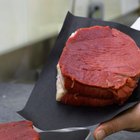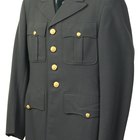
One of the world's most universal street foods is some sort of savory filling folded into a flatbread. India's dosas are a variation on this theme, and so are Turkish doner kebab, Mexican burritos, Middle Eastern shawarma and Greek or Greek-American gyros. The filling in gyros is usually meat cooked on a rotisserie, where its outer edges become crisply browned. It's tricky to replicate on a home rotisserie, but it can be done.
The Meat
Two common versions of meat are used in gyro sandwiches. In Greece, the filling is typically made with pork. Thin slices of the meat are stacked onto a spit, where they compress under their own weight. As the outer edges cook and brown, they're shaved away to fill sandwiches, leaving a fresh layer of pork exposed to the rotisserie's heat. Greek-American versions are made with ground meat, usually a mixture of beef and lamb, though pure-lamb gyros are sometimes available. The meat is formed into a sausage-like loaf, then cooked on a vertical rotisserie in the same way.
The Rotisserie
The rotisserie used in gyro shops is a special variety that holds the meat vertically as it's cooked. One to three heating elements are banked around and behind the meat, leaving the front and most of the sides free for slicing. The rotisseries on home grills and ovens -- even countertop ovens -- are invariably horizontal. They can still produce a satisfactory result, but it takes some extra work.
Sliced Meat Gyros
To make the sliced meat version of gyros meat, select a roast of pork or lamb with a diameter wider than the prongs on your rotisserie. Use a long, sharp knife to carve the meat into slices 1/8th inch or less, or ask your butcher to slice it for you. It's easiest if the meat is slightly frozen, which makes it firmer. Season the slices with salt and pepper, and herbs such as oregano, if you wish. Slide the slices onto your rotisserie's spit and secondary prongs, pressing them together as tightly as possible. Roast the meat at 400 degrees Fahrenheit or higher, periodically stopping the rotisserie and slicing away the meat from the outside. You might need to remove the spit assembly to do this.
Ground Meat Gyros
Ground meat gyros are made in much the same way as sausage, so it helps if you read a good sausage-making guide before you attempt the procedure. Whether you use lamb or a beef-lamb mixture, the meat should be finely ground, lightly salted and thoroughly chilled. Process the meat to a smooth paste in your food processor or stand mixer, adding ice water or crushed ice as directed in your recipe. Form the meat into a log shape, wrap it in parchment paper, and then in foil. Wrap the entire log in heavy-duty plastic wrap, then poach it in 180 F water until its internal temperature reaches 160 F. Let the log cool, then transfer it to your rotisserie's spit. Slice away the outer layers as they brown, and use them to make your gyros.
Related Articles

What Is Hog Casing Made Of?

Do You Cold-Smoke Venison Sticks or ...
How to Cook Prime Rib on an Electric ...

How to Cook 1/4-Inch Thick Pork Chops
How to Barbecue Prime Rib Bones

What Type of Knife to Carve Prime Rib?

How to Cook a Juicy & Tender Lamb Leg

How to Cut a Cooked Pork Shoulder

How to Slice Round Steak for Jerky

Tools Used in Food Processing

How to Cook Butterfly Pork Tenderloin ...
How to Cook Buffalo Fillet

How to Grill a Ribeye on a Weber Q

How to Bake a Dry Rubbed Corned Beef ...

How to Wear Fourragere

How to Cook Beef Sweetbreads

How to Sharpen a Meat Slicer Blade

How to Cook Prime Rib Using an Oven ...

How to Apply I Tip Hair Extensions

How to Carve a Bone-In Ribeye
References
- A New Book of Middle Eastern Cooking; Claudia Roden
- Garde Manger: The Art and Craft of the Cold Kitchen; Culinary Institute of America
- Fine Cooking: The Secret of Spooled Gyro Meat
- Serious Eats: The Food Lab -- Homemade Greek-American Lamb Gyros
Writer Bio
Fred Decker is a trained chef and prolific freelance writer. In previous careers, he sold insurance and mutual funds, and was a longtime retailer. He was educated at Memorial University of Newfoundland and the Northern Alberta Institute of Technology. His articles have appeared on numerous home and garden sites including GoneOutdoors, TheNest and eHow.
Photo Credits
Jupiterimages/Comstock/Getty Images